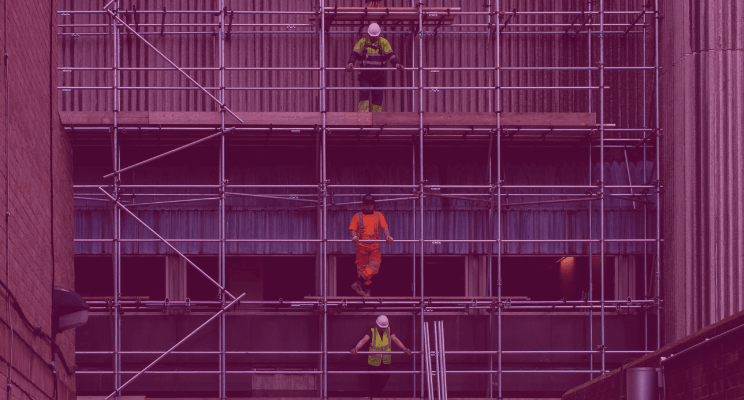4 things construction teams need to understand about BIM in 2019

2019 is a big year in construction. BIM is coming into its own and the possible outcomes are continuing to expand. For teams looking to move beyond regulations and grasp the truly transformational impacts that BIM is able to create, now is the time to get ahead of the curve when it comes to future developments in BIM.
BIM delivers process, workflow and technological opportunities that impact every level of the construction team — structural engineers and architects all the way to interior designers. Here is a quick list of 4 things you need to understand about BIM to benefit in 2019.
1. BIM’s potential goes far beyond the regulations and BIM Level 2
UK regulations define BIM processes under several categories. The first is BIM Level 0, which describes traditional CAD (computer-aided design) technology. BIM Level 1 introduces non-graphical data and objects that deliver information about non-structural assets — effectively object-oriented CAD.
Since April 2016, all publicly funded construction projects in the UK have required BIM Level 2. To meet BIM Level 2 standards, construction teams must embrace collaboration through the use of interoperable export formats and easy sharing tools — creating a common data environment (CDE).
While BIM Level 2 represents a real improvement in collaborative standards, it is a far cry from what BIM has, arguably, always supposed to have been. This is relegated to the still undefined BIM Level 3 category. So, what is BIM?
The true potential of BIM is single-source-of-truth, database-first design technology and processes. Here, all structural and design information is stored centrally. Rather than specialists (structural engineers, architects, interior designers, builders etc.) all creating and using separate files, each access and edit elements of a common dataset. Files are ‘spun-up’ and used with familiar CAD tools, but all, ultimately, are part of a single, common schematic.
It has been shown that the incorporation of Level 2 BIM improves the efficiency of projects by up to 20%. The true potential of the database-first, single-source-of-truth processes catapult this to even greater, yet un-quantified heights. Teams might be required to implement BIM Level 2 capabilities, but should aim much higher if attempting to deliver the best outcome possible to clients and maximise internal efficiencies.
2. BIM’s impact depends on process changes
BIM has huge potential, but it all ultimately comes down to individual construction and design teams to create processes that take advantage of these opportunities. BIM is enabled by software. But, the value of BIM technology on its own is rather limited.
When people talk about BIM and the value of BIM, what they are really referencing are the process improvements that collaborative software technology creates. If BIM-enabled technology is simply used within traditional workflows, few benefits will be derived.
The most notable capabilities of BIM revolve around coordination, collaboration and communication. BIM is an extension of CAD that essentially allows the various individuals within the team (architects, builders, project managers, etc.) to work on their individual CAD programs and plans while knowing that all data is collated in one environment. This includes having changes on one design being implemented across the board so that all plans are synced. Notifications can even allow teams to see/discuss those amendments.
BIM essentially enables teams to execute their construction plans in greater harmony across specialisations, which is especially useful when teams are (as is often the case) spread across multiple geographic locations. This can make it simpler to finalise projects. But, more radically, it opens up the door for greater collaboration between design and structural teams during design to push the structural limits of architecture — experimenting with materials, designs and manufacturing techniques.
Furthermore, the use of graphical CAD elements and non-graphical object data enables teams to produce even more detailed schedules, plans and models — making construction a smoother and more predictable process. This also improves client interactions, allowing them to view progress and interact with the plans in an efficient and insightful manner. Sequential models uncover details throughout every stage of the process while the cloud-based elements promote easy access for those with the right credentials. While BIM Level 2 can achieve this goal to a degree, it underlines the fact that, when used correctly, BIM Level 3 takes construction projects to another level. But, at its core, the technology is only useful when it enabled improved processes.
3. The future of BIM is scan-to-BIM
BIM is primarily considered to be a process for building plans as a design-first technology that can deliver 3D drawings, 4D and 5D models, isometric drawing plans and various other elements. However, there is an increasing number of teams that are incorporating reality capture technology within their BIM processes.
This can be done to inform the foundations of a BIM schematic, assess progress throughout construction, create as-built BIM datasets for renovation projects, or to aid with the maintenance of older structures. This advanced 3D surveying technology uses point clouds to build exact datasets, bringing real-world assets into the digital space and unlocking a wealth of new possibilities at every stage of the project.
The application of BIM-enabled processes in renovation projects is made easy, and planning for site locations complicated by hazards or surrounding buildings is made simple by being able to directly incorporate these features into modelling. By scanning stages of construction for comparison in exacting detail with plans, near 100% quality assurance guarantees can be made. The detail of BIM schematics by themselves make it easier to use prefabricated materials. But, the diligence of scan-to-BIM technology makes this simple, even while using experimental manufacturing techniques like 3D printing.
While scan-to-BIM is still in its infancy, the sector has grown continuously. This has been spurred both by the broadening application of BIM technology in general, and advancements in point cloud processing software and the survey industry itself. New multistage, vector-based, point cloud processing software has made the use of targetless scanning processes a viable option that greatly reduces the cost of commissioning a point cloud survey. As more survey companies come to use this technology, the cost-effectiveness of scan-to-BIM will improve and it will become an integral aspect of the overall BIM process and technology portfolio.
4. The benefits of BIM go beyond construction
As an extension of CAD, BIM is often thought of as something simply connected to the construction of a project. However, construction costs account for just 10%-20% of the total cost of a structure — with maintenance playing a far more significant overall role. This is another area where BIM can transform the way teams handle a project, especially when using scan-to-BIM technologies and processes.
It is important for design teams to consider the utility of their schematics to post-construction maintenance and management teams. If design teams want to deliver the best outcome possible to clients, that means including information that will be valuable to post-construction management, as well as the construction process. These post-construction benefits also have a place in client pitches, allowing for the articulation of lower total cost of ownership figures.
BIM delivers a great central platform for understanding a building, tracking maintenance, ongoing costs and capabilities. It also helps in the event of an issue. For example, if a leak is found in a section of a building, it is possible for teams to investigate a virtual model to gain a deeper understanding of the issue and how best to treat it. In addition to time being money, it could prevent dangerous situations.
Summary: The power of BIM is only just becoming understood
BIM is not the new kid on the block that it once was. But, that really means that it is about to become truly meaningful. If you think about any technological development, it is not until that technology goes mainstream that real benefits start to be seen. As BIM becomes widely used, more professionals will gain experience in how to operate with these new collaborative data environments and single-source-of-truth datasets, developing process changes to their workflows that will be the source of dramatic improvements.
It is only through individuals changing how they work to take advantage of the technological side of BIM that construction, design and building maintenance will improve. We have gone through the BIM marketing hype and the renaming of old software as ‘BIM’. We are now seeing the adoption of ‘true’ BIM, single-source-of-truth technology. Making sure that you are on that side of the BIM software divide is the first step to making the most out of BIM in 2019. The next step is to look hard at how your entire team is coordinating and using the technology you have.
Try to think of unique ways in which you can develop cross-specialist capabilities to improve, expand and develop new benefits from the evolving technological landscape. Part of that should be incorporating scan-to-BIM solutions into your existing processes. But, the possibilities are nearly limitless.
You have been reading about how to benefit from BIM in 2019. If you still have questions about how to get started with BIM, determine which BIM software solutions are best, or figure out how to update your processes, we have written an Ultimate Guide to BIM just for you.
Tags: bim

